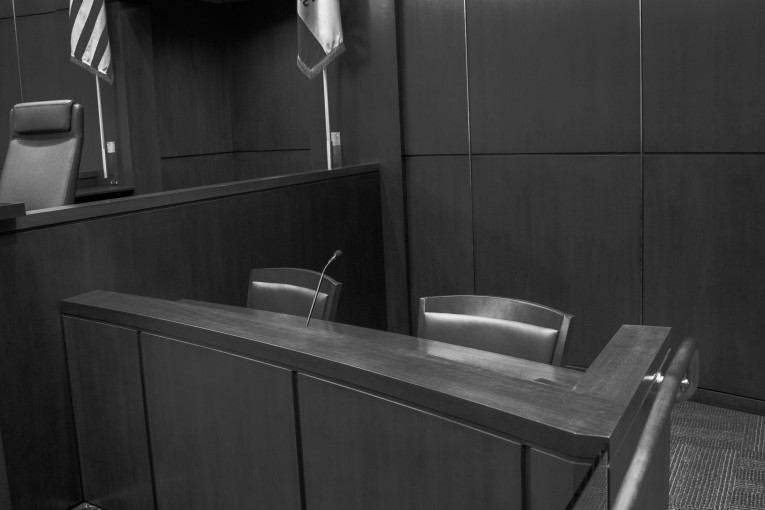
 By Jade Wolansky
By Jade Wolansky
The first witness to come to the stand was Detective John Ney, with the Yolo County Sheriff’s Office and its Gang Task Force. He had been recalled from the previous day for further testimony. The prosecutor, Deputy DA Kyle Hasapes, asked Det. Ney why he had summarized a witness’ words in his statement. Det. Ney answered that he saw no need to give a verbatim account, since the interview was recorded.
The next to testify was another recalled witness, Woodland Detective Pablo Gonzales.
Ms. Sequeira questioned him on the statements he had collected from a witness about the July 1, 2016, incident. Ms. Sequeira asked if the witness to the incident had described two vehicles, one light-colored and one dark-colored, that had passed by at high speed on her street. Det. Gonzales affirmed that the witness had said that, and he said that the witness had also stated that the dark-colored car was always trailing the light-colored car.
Mr. Hasapes next asked Det. Gonzales for facts about the witness. Gonzales stated that the witness was approximately 70 years old. Mr. Hasapes proceeded to ask if Det. Gonzales believed the witness to be confused. Gonzales replied that she seemed clear on what she had seen.
The rest of the preliminary hearing was focused on questioning the next witness, Detective Aaron Moe, an investigator for the Yolo County District Attorney’s Office. He currently serves as a member of Yolo County Gang Task Force and has been an expert witness in Woodland, Yuba, Sutter and Butte Counties. He has received certifications and training, and has been involved in investigating gang-related crimes.
The defense challenged Det. Moe’s credibility as a Woodland gang expert.
Ms. Sequeira argued that any police officer had equal access to the resources that qualified Det. Moe as an expert witness. She also questioned the criteria the Yolo County Gang Task Force utilized for identifying gang members. She believed that supervisor and peer review was not sufficient to affirm whether their evaluations were accurate. Sequeria had Det. Moe admit he had first testified as an expert witness only two weeks after becoming an officer.
The defense then requested that Judge Reed call into question whether Det. Moe should be qualified as an expert witness. Judge Reed decided Det. Moe was sufficiently qualified for the purposes of the preliminary hearing.
Next, Mr. Hasapes began his examination of the witness. Det. Moe testified about Woodland gang culture and dynamics. He explained that “VBN,” or “Varrio Bosque Norte,” was a subset of the larger Norteño criminal street gang. He stated that they had a rivalry with the Sureño gang.
He stated that Norteño gang members affiliate themselves with the color red, the number 14, and that they use gang symbols that represent the letter “B.” The Sureño gang use the color blue, and associate themselves with the number 13. Gang members have loose and shifting leadership, since leaders often have been imprisoned or have moved away. General members are known as soldiers, and they commit various crimes to gain status within the gang.
Det. Moe explained the history of the Norteño gang’s origin. The gang had started in the state prison system as a defense against the Mexican Mafia, also known as the Sureño gang. Norteño gang members use the derogative term “scrap” to refer to Sureños. Similarly, the Sureños use “busters” to refer to Norteños.
At this point, Mr. Sequeria objected and asked the purpose of Mr. Hasapes’ line of questioning. He answered that he believed that the Quezada murder case was a result of a gang altercation between Norteño and Sureño gang members.
Mr. Hasapes reminded the court that, in a previous testimony, two female passengers in the victim’s vehicle wore blue hats.
Mr. Hasapes halted momentarily and asked permission to approach the bar. He obtained several of the People’s exhibits. The exhibits included documents related to the defendant’s past conviction. Mr. Hasapes showed them to the witness and asked him if he recognized any of the names listed as known VBN gang members.
Ms. Sequeira objected and cited the California Supreme Court’s ruling in People v. Sanchez (2016) and the Crawford rule (from Crawford v. Washington in 2004, which set in place a stricter standard for the admission of hearsay evidence, as related to the 6th Amendment’s confrontation clause). She argued that the prosecutor was violating the defendant’s 5th and 6th Amendment rights.
She stated that the prosecutor was having the witness affirm evidence about which he did not have personal knowledge. She then requested the court to read the Sanchez court case.
The prosecutor countered that Sanchez nonetheless permitted him to continue questioning Det. Moe. Mr. Hasapes stated that, in the court case ruling, an expert witness may rely on hearsay to give their opinion so long as they testify about general information. It is up to the jury to determine whether they will consider this information when reaching a verdict.
Mr. Hasapes next requested Ms. Sequeira to stipulate to several facts of the case, from after the incident. These requests included that the defendant had initially tried to avoid arrest when they arrived at the apartment he was sharing with his girlfriend, and that the victim had died from gunshot wounds. Ms. Sequeira acknowledged and so stipulated.
Shortly after, the court took a 15-minute break to review People v. Sanchez and how it would apply to the preliminary hearing.
When Judge Reed returned he explained that a witness’s general answers would not be limited by the Sanchez ruling. However, case-specific answers would not be admissible for the truth of the matter. The only exception would be if the witness had personal knowledge of the information.
Judge Reed then said the preliminary hearing would resume on August 4, 2016.
